Plants are essential for an aquarium as you can not just keep your sea pets in a tank and hope they survive for long in a glass tank filled with water.
An aquarium plant can help your fish tanks remain clean and oxygenated throughout the day.
Fish produce a lot of waste, and plants can also help clean that up. Other than being beneficial for your pets, plants in aquariums also help increase the aesthetics of the fish tank.
The more vibrant colored plant you place in your aquarium, the better it looks. Thus, here are some colorful plants that you can use to make your aquarium lively and animated.
The Best Colorful Aquarium Plants
- Ludwigia Repens
- Echinodorus Cordifolius
- Rotala Rotundifolia
- Ammania Senegalensis
- Alternanthera Reineckii
- Ludwigia Palustris
- Pogostemon Stellatus
- Cryptocoryne Wendtii, Red
- Lobelia Cardinalis
- Rotala Indica
- Red Tiger Lotus
- Rotala Yao Yai
1. Ludwigia Repens
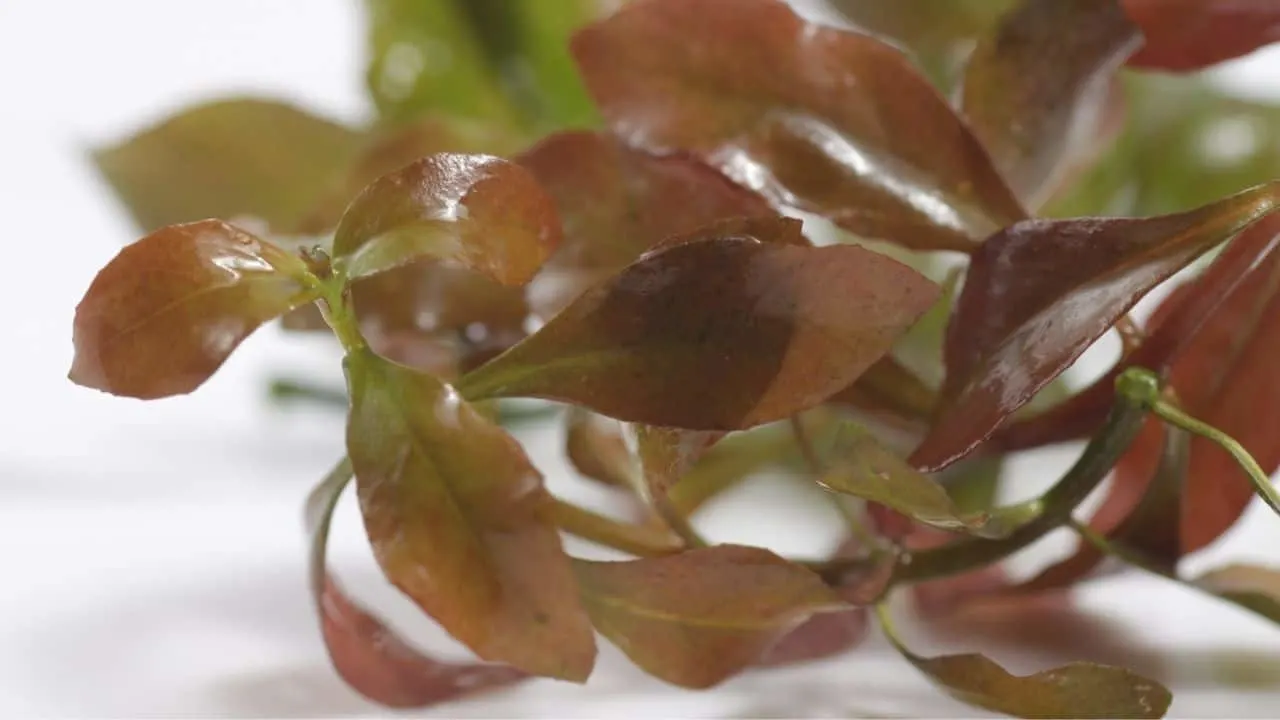
Ludwigia Repens is a beautiful plant that is mainly found in red. It comes from the following two countries of Northern America:
- United States
- Mexico
It is an extremely easy plant to grow for beginners, and you do not need to stick to any strict rules. This plant is perfect for your aquarium as it will add a tint of color without much effort.
Its binomial nomenclature and basic plant care requirements include:
- Scientific name: Ludwigia Repens
- Max height: 12–20 inches (30 to 50 cm)
- Care complexity: moderate
- Lighting needs: high or medium lighting
- Growth rate: Fast
- Additional CO2 required: not required
- Recommended position: mid-ground or background
- Fertilization: Can grow without fertilization
- Temperature: 75 to79 degrees Fahrenheit (24-26 degrees Celsius)
This is a medium-sized plant. This means you should keep the plant in a medium to a large aquarium.
If you put it in a small one, your plant will not have enough space to grow, which affects your aquarium pets’ comfort.
2. Echinodorus Cordifolius
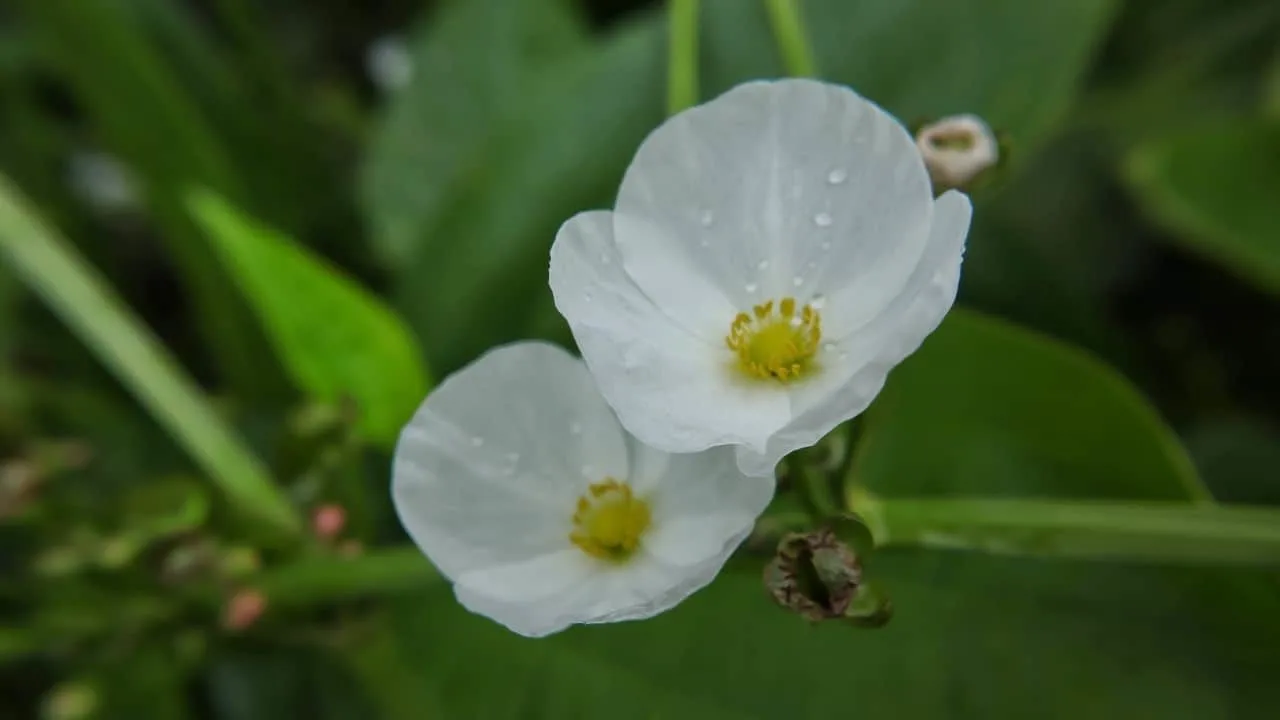
Echinodorus Cordifolius grows above the water line in your tank. So, if you do not prune it properly, your aquarium can start to look like a mess.
This plant reproduces through rhizome division and side shoots. If you find that your Echinodorus Cordifolius has become too tall, you can easily trim it.
You can find this aquatic plant in the following colors:
- Red
- Purple
- green
Its binomial nomenclature and basic plant care requirements include:
- Scientific name: Echinodorus Cordifolius
- Max height: 2 to 4 inches (60cm – 120cm)
- Care complexity: Easy
- Lighting needs: Medium to high
- Growth rate: Fast
- Additional CO2 required: not required
- Recommended position: At the center or in the background
- Fertilization: root tabs
- Temperature: Somewhere between 72 to 84 Fahrenheit (22 to 28 degrees Celsius)
Echinodorus Cordifolius is extremely intolerant of copper, so you need to make sure your aquarium remains purified not just for your plants but also for your fish.
It will also be beneficial for the plant if you provide it with fertilizers high in nitrogen and iron.
3. Rotala Rotundifolia
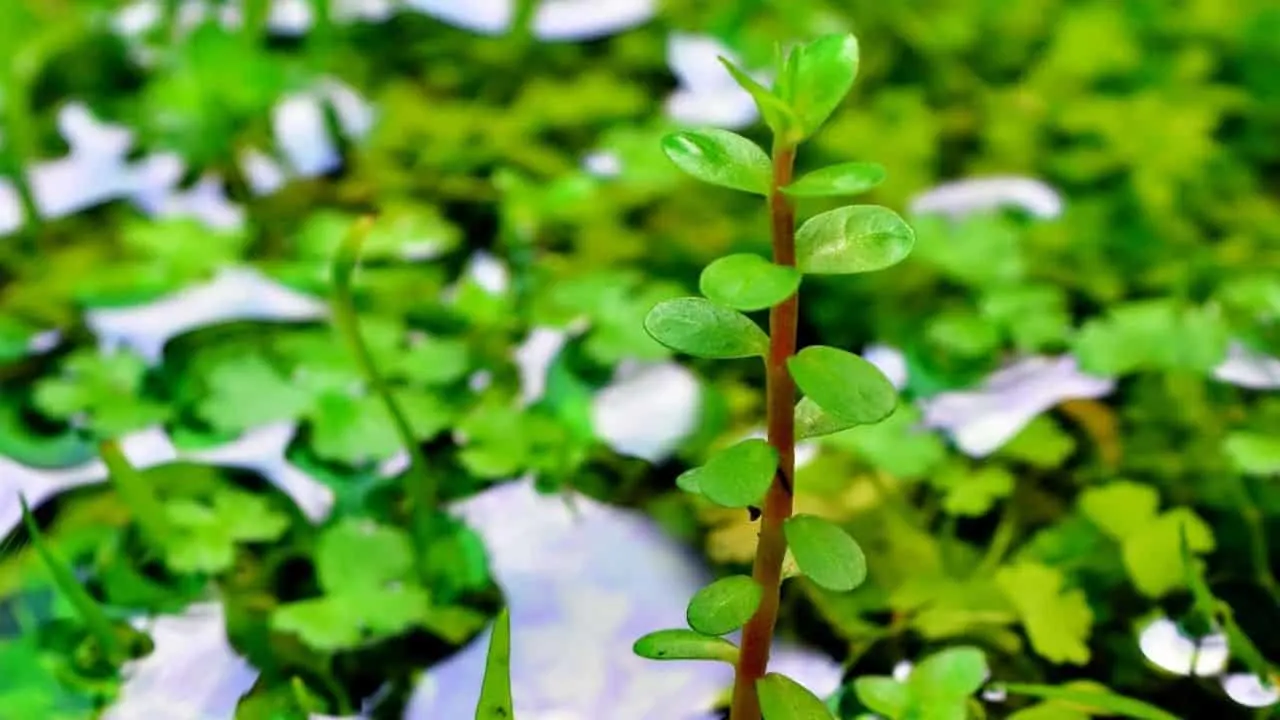
Rotala Rotundifolia is a fast-growing plant that grows well if it is frequently pruned. You need not become an expert in plant care to take care of this species.
It is also great at regulating the environment in newly cycled aquariums. Rotala Rotundifolia comes in the following colors:
- Red
- Yellow
- Green
- Orange
Its binomial nomenclature and basic plant care requirements include:
- Scientific name: Rotala Rotundifolia
- Max height: 8-12 inch (20-30cm)
- Care complexity: Moderate
- Lighting needs: medium to high
- Growth rate: Fast
- Additional CO2 required: does not need it
- Recommended position: at the center or in the background
- Fertilization: Root tabs
- Temperature: 70 to 86 degrees Fahrenheit (21 to 30 degrees Celsius)
4. Ammania Senegalensis
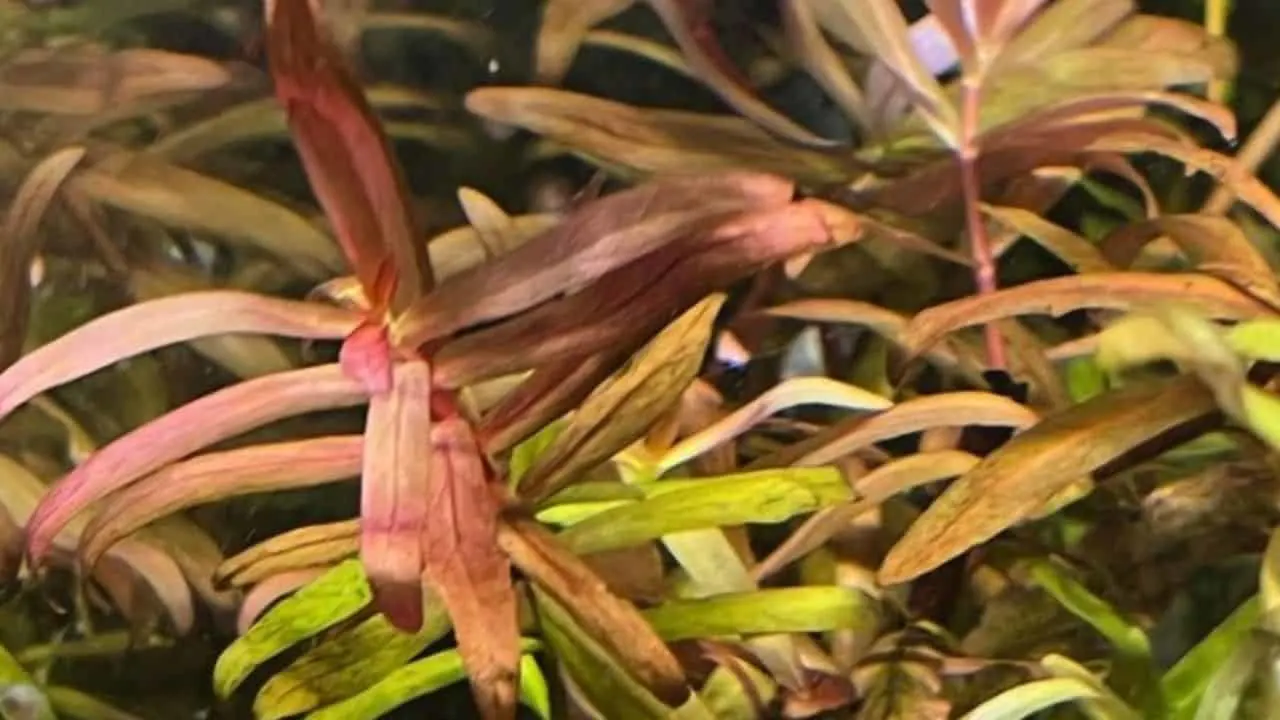
Photo Credit: @aquaticspauls on Instagram!
Ammania Senegalensis is an exceptionally colorful plant. It is new to many people as even fish keepers and aquarium hobbyists do not know much about this plant.
However, what is known is that with proper care, your Ammania Senegalensis can make your whole aquarium colorful and vibrant.
Ammania Senegalensis comes in these colors:
- Green
- Orange
- Yellow
- Red
Its binomial nomenclature and basic plant care requirements include:
- Common name: Copperleaf Ammania
- Scientific name: Ammania Senegalensis
- Height: 15-20 inches (40-50 cm)
- Care complexity: Moderate to difficult
- Lighting needs: At the center or in the back
- Growth rate: Fast
- Additional CO2 required: needs CO2 injections
- Recommended position: Middle to background
- Fertilization: occasional fertilization required.
- Temperature: Between 68 to 82 degrees Fahrenheit (20 to 27 degrees Celsius)
Ammania Senegalensis also needs high amounts of iron for its health and to maintain its vibrant colors.
5. Alternanthera Reineckii
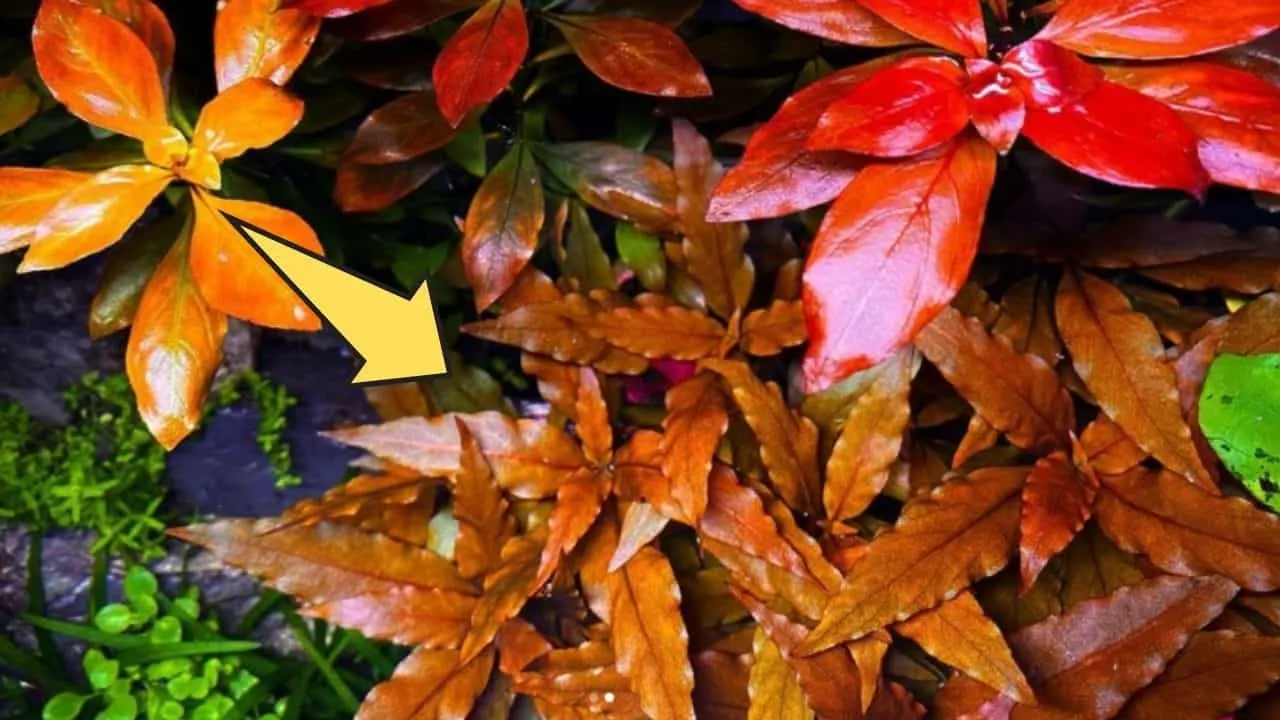
Photo Credit: @aquatechbetta on Instagram!
This species is known for its vibrant colors. You can grow it into a tall plant or keep it as a mini one.
This plant is also generally very slow-growing, which means that it is a great investment for people who are new at caring for aquarium plants.
This aquatic plant’s available in the following colors:
- Pink
- Red
- Orange
Its binomial nomenclature and basic plant care requirements include:
- Common name: none
- Scientific name: Alternanthera Reineckii
- Height: can grow 10 to 20 inches tall (25 to 50 cm)
- Care complexity: Easy to moderate
- Lighting needs: Moderate to bright
- Growth rate: Fast
- Additional CO2 required: Requires Co2 injections
- Recommended position: Foreground, midground, or background (depends on variety)
- Fertilization: needs high nitrates and high phosphates fertilizers
- Temperature: Between 71.6 and 82.4 degrees Fahrenheit (22 to 28 degrees Celsius)
Alternanthera Reineckii is a very forgiving plant, so if fail to feed it for a few weeks, it won’t die.
This plant prefers to be tripped without getting uprooted. If you have to move your Alternanthera Reineckii plant around, then do it carefully.
Instead of uprooting your plant, you can cut off the tall shoots.
However, pruning your plant this way will only give you dense growth, and it will be left with very little recovery time.
6. Ludwigia Palustris
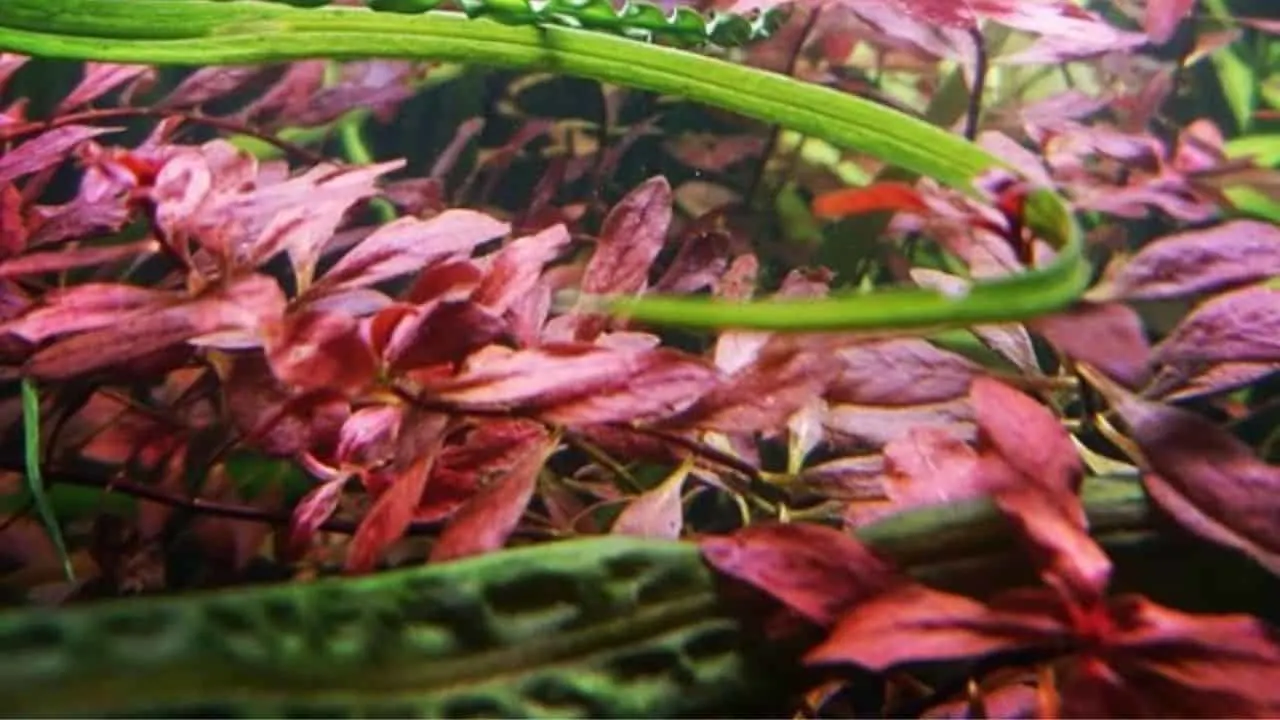
Photo Credit: @nax_and_the_shrimps on Instagram!
Ludwigia Palustris is a stunning aquatic plant that needs a substrate that is rich in iron.
It is known for its beautiful red leaves and grows well with CO2 supplementations, even though it is not necessary to provide it.
You can trim your plant to replant even more Ludwigia Palustris as it is easy to grow. Its binomial nomenclature and basic plant care requirements include:
- Scientific name: Ludwigia Palustris
- Height: 4 to 12 inches (10 – 30+ cm)
- Care complexity: Easy
- Lighting needs: Medium to bright
- Growth rate: medium
- Additional CO2 required: not needed
- Recommended position: Middle to background
- Fertilization: can grow without fertilizers, but root tabs are recommended
- Temperature: 59-77 degrees Fahrenheit (15-25 degrees Celsius)
7. Pogostemon Stellatus
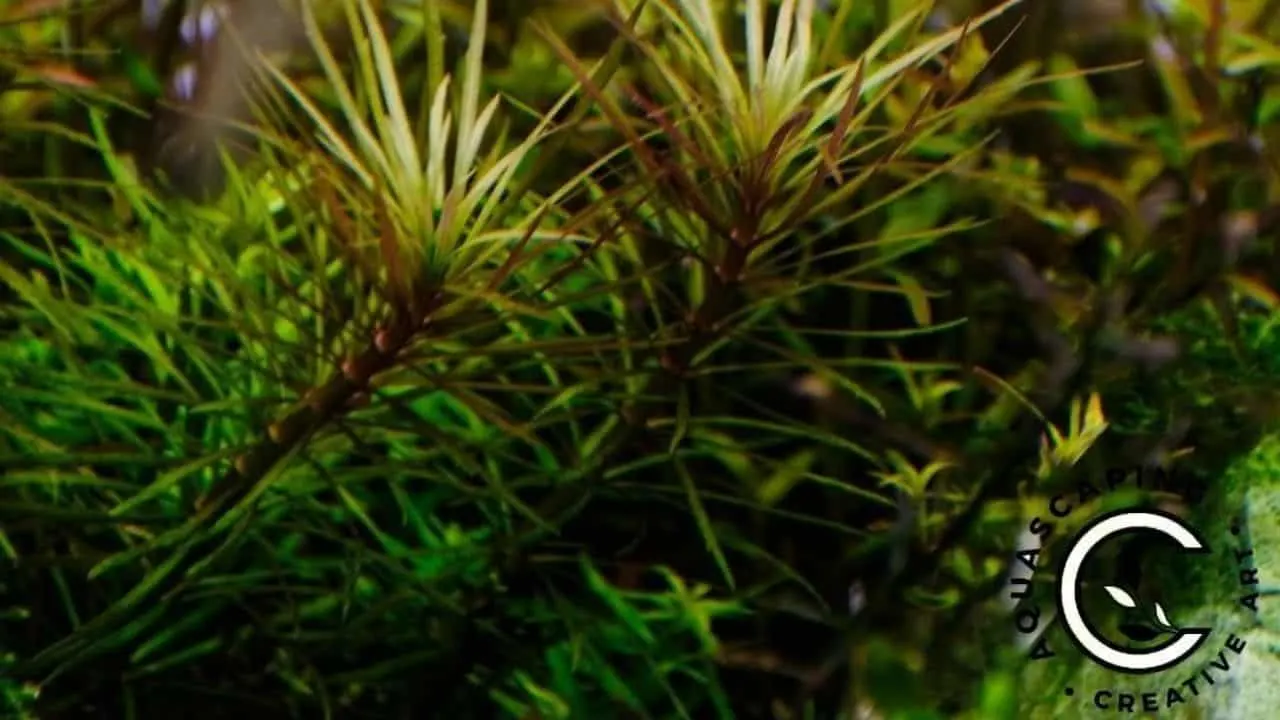
Photo Credit: @aquascapingcreativeart on Instagram!
Pogostemon Stellatus is another new plant in the aquarium world.
Beginners can have a harder time growing this plant in various colors, mostly because a lack of popularity is reducing the number of tips available to grow it in different colors.
Its binomial nomenclature and basic plant care requirements include:
- Common name: Broadleaf
- Scientific name: Pogostemon Stellatus
- Height: 6 to 12 inches (15 – 30+ cm)
- Care complexity: Moderate
- Lighting needs: High
- Growth rate: Fast
- Additional CO2 required: needs extra CO2
- Recommended position: At the center or in the back
- Fertilization: needs liquid fertilization
- Temperature: Between 59 and 90 degrees Fahrenheit (15 to 32 degrees Celsius)
You can find Pogostemon Stellatus in these colors:
- Green
- Red
- Whitish-yellow
Pogostemon Stellatus is a prolific plant, if you can take proper care of it. Despite the high-tech setup needed to grow this plant over time, it becomes easier to maintain.
8. Cryptocoryne Wendtii, Red
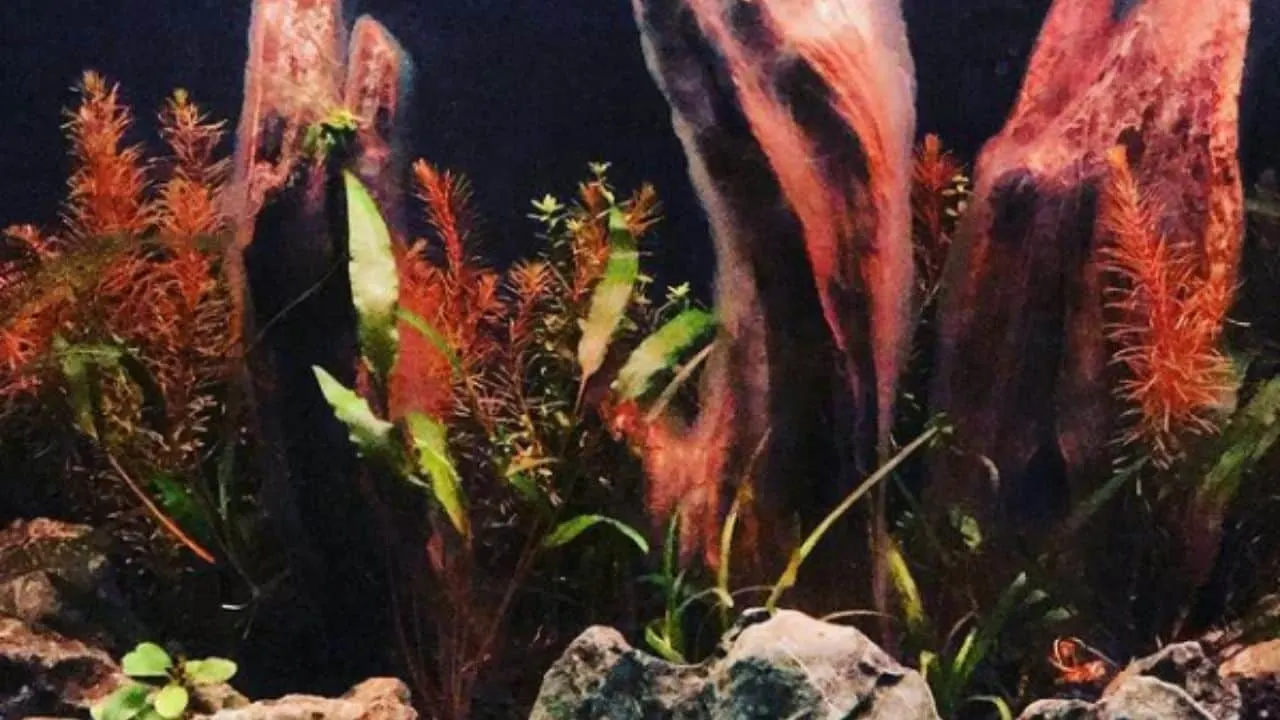
Photo Credit: @paula_underwater on Instagram!
Cryptocoryne Wendtii in red is a popular plant amongst enthusiasts as it requires extremely low lighting. It is also a simple plant to care for, and you can use it in aqua scaping.
Quite a well-known crypt, this plant is found in Southeast Asia. It can easily be found in various sizes and colors. This plant’s colors include:
- Green
- Red
- Yellow
- Orange
Its binomial nomenclature and basic plant care requirements include:
- Common name: none
- Scientific name: Cryptocoryne Wendtii Red
- Max height: 6 inches (15 cm)
- Care complexity: Easy
- Lighting needs: Low to moderate
- Growth rate: Fast
- Additional CO2 required: It is not required
- Recommended position: Foreground to Midground
- Fertilization: should be regularly fertilized
- Temperature: 74-84 degrees Fahrenheit (23 to 28 degrees Celsius)
One of the main reasons this plant has become an instant favorite is because it needs low light, so low-tech equipment needs to be used.
Beginners will have no issues handling this plant, and this also means that you do not need to spend extra money on a light.
The only thing that will affect the vibrant colors is a lack of substrate containing iron. Thus, you should use iron supplements to help with growth.
9. Lobelia Cardinalis
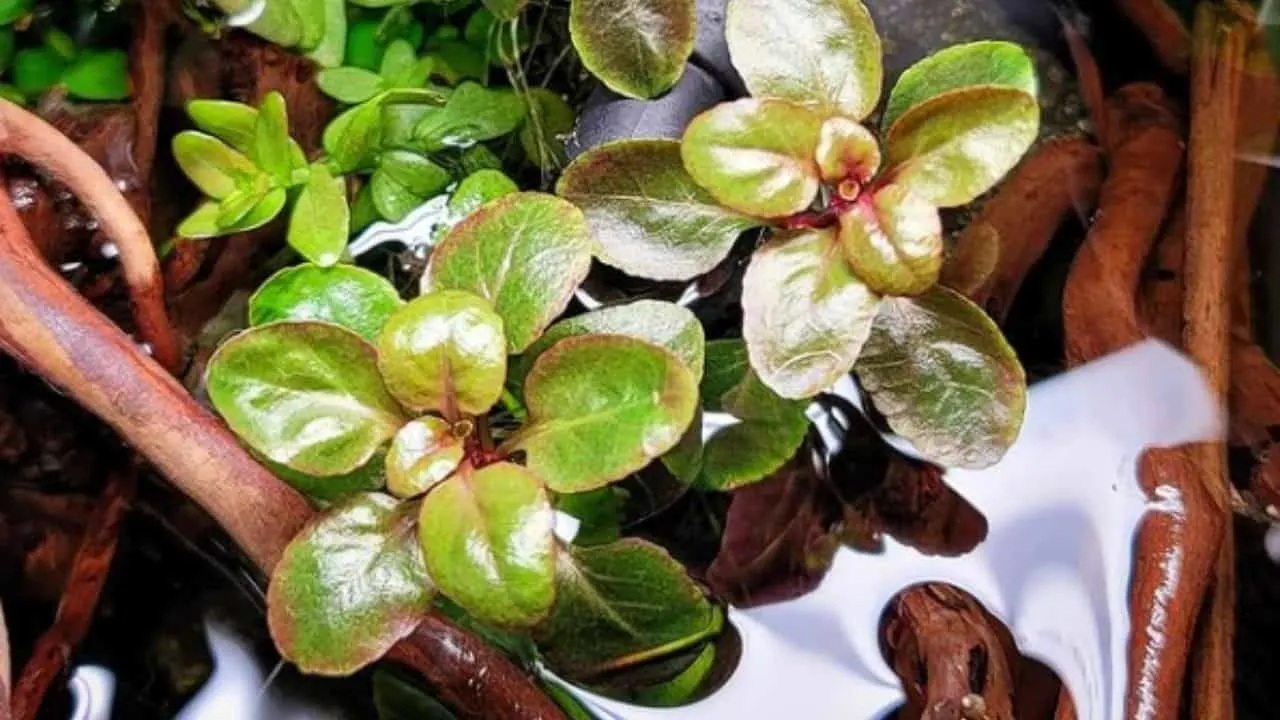
Photo Credit: @walkers_aquatic_gardens on Instagram!
Lobelia Cardinalis is a versatile plant that comes from North America. It is a lovely species that only grows between four to twelve inches which means you can plant several of them in your aquarium.
Its binomial nomenclature and basic plant care requirements include:
- Scientific name: Lobelia Cardinalis
- Max height: 4 and 12-inches (10 to 30 cm)
- Care complexity: Not very demanding
- Lighting needs: Medium to bright
- Growth rate: Medium
- Additional CO2 required: Moderate amount of CO2 required.
- Recommended position: At the front or the center
- Fertilization: Not required
- Temperature: 63-82 degrees Fahrenheit (17 to 27 degrees Celsius)
When Lobelia Cardinalis is submerged underwater, the leaves look bright green, and the part under the leaves gives off a red-purple color.
10. Rotala Indica
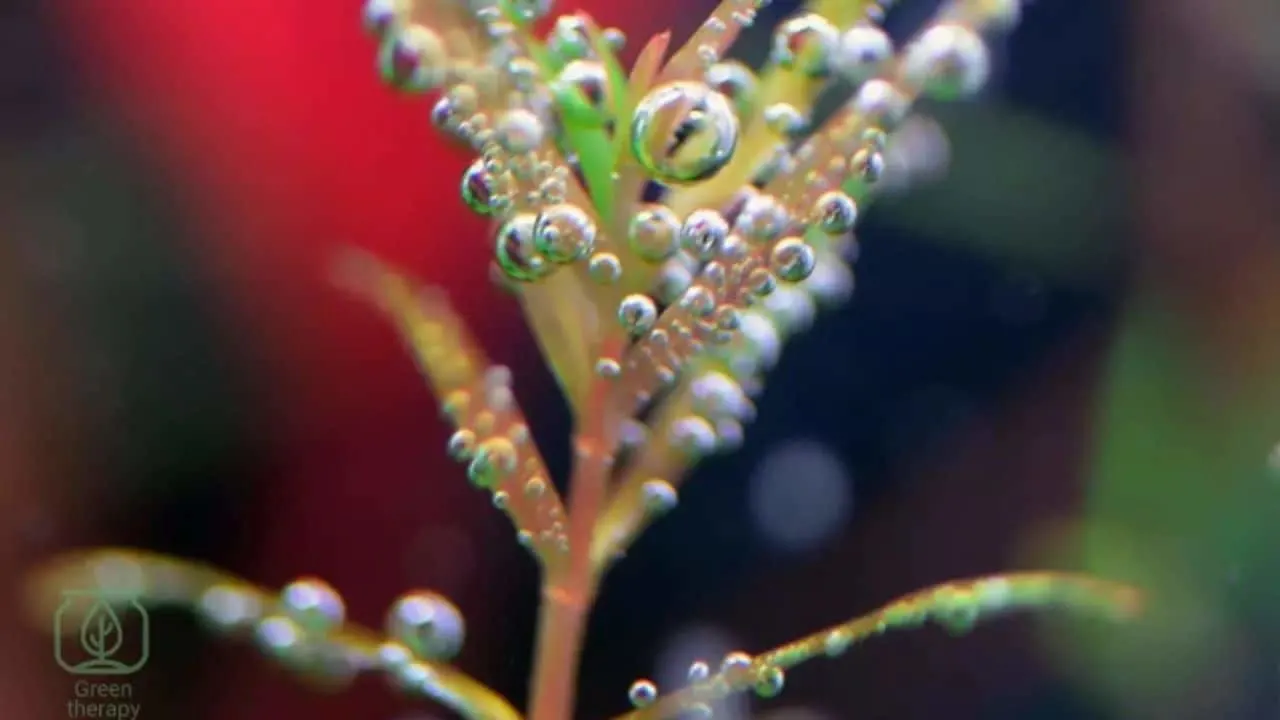
Photo Credit: @greentherapy.art on Instagram!
Rotala Indica is a creeping plant that spreads across the aquarium once it has matured. The plant added beautiful colors to your fish tank as even flowers grow from it.
This is also a very fragile plant and should not be kept with animals or fish that are large and highly active.
Its binomial nomenclature and basic plant care requirements include:
- Scientific name: Rotala Indica
- Max height: 2 to 8 inches (5 to 20 cm)
- Care complexity: Moderate
- Lighting needs: High
- Growth rate: Fast
- Additional CO2 required: does well even with CO2 in the tank
- Recommended position: At the front or in the middle
- Fertilization: Require it. root tabs work best
- Temperature: Between 64 and 86 Fahrenheit (18 to 30 degrees Celsius)
11. Red Tiger Lotus
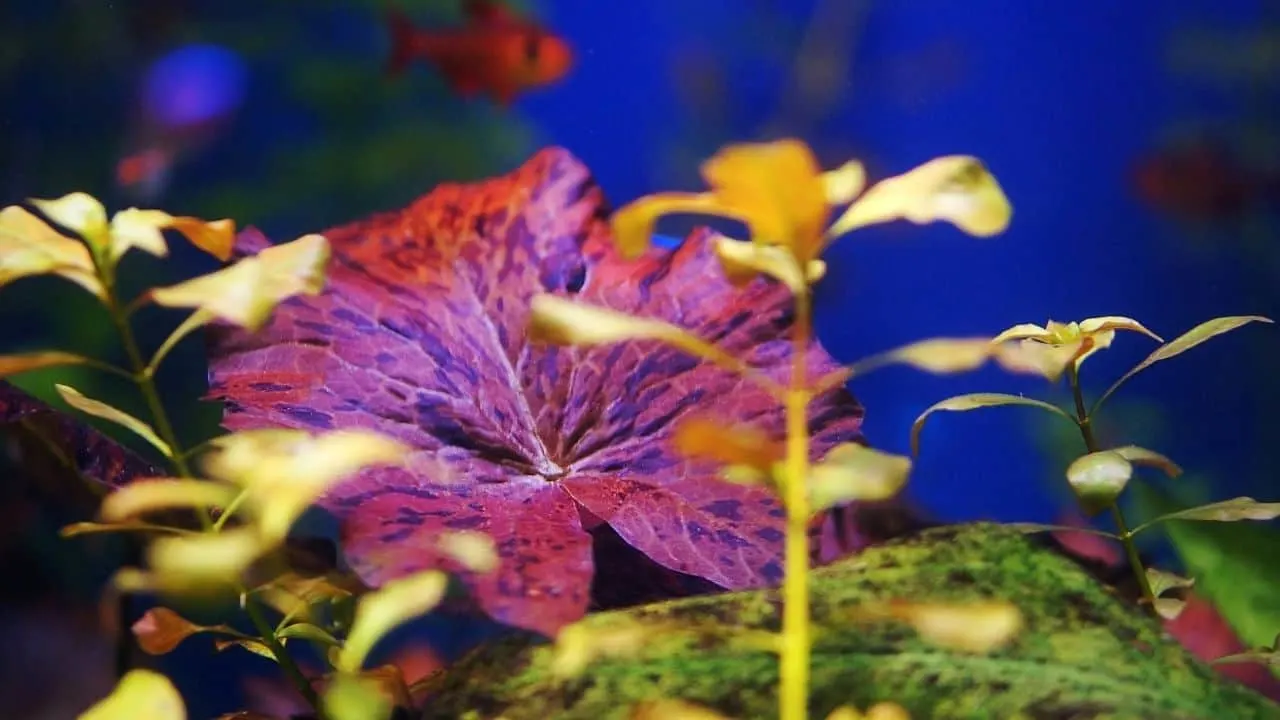
Red Tiger Lotus is also a red plant seen in many aquariums. It comes from:
- West Africa
- Southeast Asia
Many people are unaware that the Red Tiger Lotus plant is actually a water lily. This is why you can find this plant in stagnant and shallow waters, just like other water lilies.
Its binomial nomenclature and basic plant care requirements include:
- Common name: Red Tiger Lotus
- Scientific name: Nymphaea Zenkeri
- Height: 7-31 inches high and 9-23 inches wide
- Care complexity: Easy to Moderate.
- Lighting needs Moderate to High.
- Growth rate: Fast
- Additional CO2 required: not needed (but can live without it)
- Recommended position: Midground or Background plant
- Fertilization: Root tabs and Liquid fertilizer
- Temperature: ranges from 72-86 degrees Fahrenheit (22 to 30 degrees Celsius)
Red Tiger Lotus is an easy plant to grow, but you can make it even easier to take care of by:
- Providing it with extra nutrients so that it does not leave other plants malnourished
- Don’t try aqua scaping with it as they grow extremely fast
- Contain its growth by tripping or root containing.
12. Rotala Yao Yai
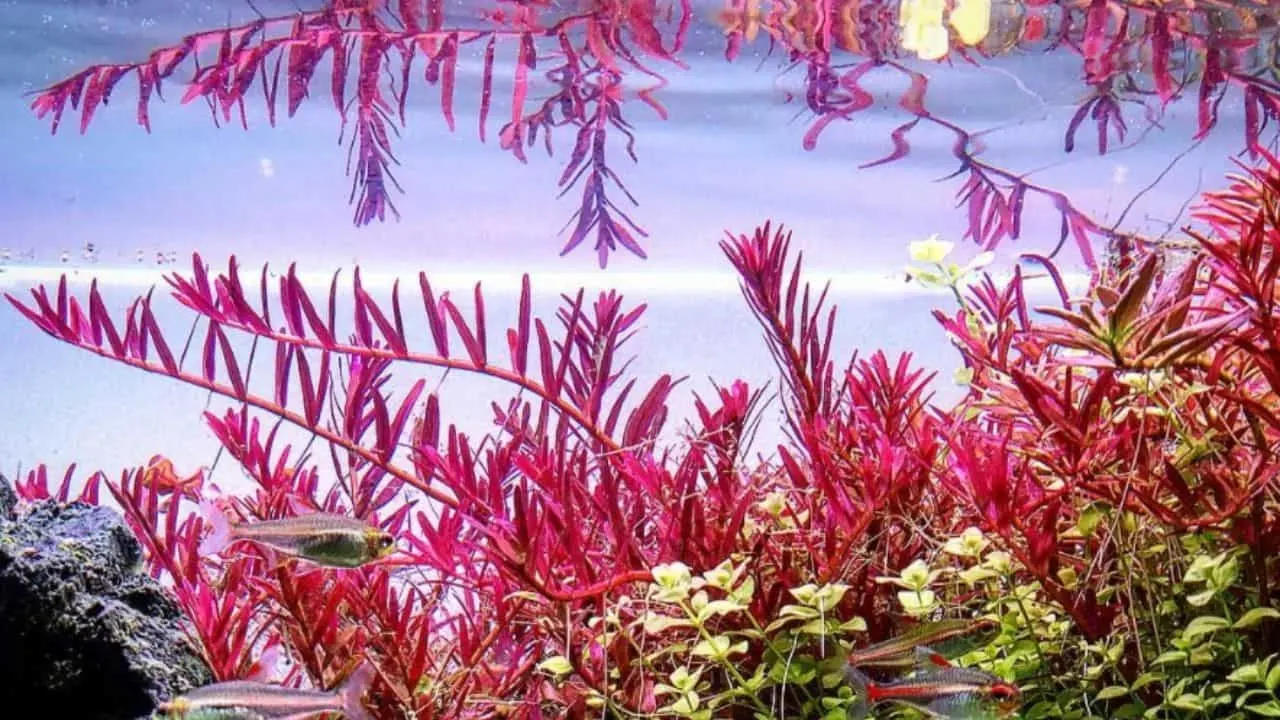
Photo Credit: @kaminature on Instagram!
Rotala Yao Yai is not a common plant within the aquarium plant world. However, it has many attractive qualities that can liven up your aquarium.
This plant is mostly considered red, but it has an orange to pinkish hue color in its branches.
Its binomial nomenclature and basic plant care requirements include:
- Common name: Rotala Yao Yai
- Scientific name: Rotala sp. ‘Colorata’
- Height: 4 to 10 inches (10 to 25 cm)
- Care complexity: easy
- Lighting needs: Medium to High
- Growth rate: Moderate to Fast
- Additional CO2 required: needs it to grow well
- Recommended position: Background
- Fertilization: needs fertilizers
- Temperature: 39 to 86 degrees Fahrenheit (4 – 32 degrees Celsius)
Conclusion
All of these plants are known to grow in a variety of colors when planted in aquariums.
The species mentioned above are not only just vibrant, but they also have benefits in terms of providing oxygen and clearing out carbon dioxide, and keeping the water environment clean.

Daniel has been a plant enthusiast for over 20 years. He owns hundreds of houseplants and prepares for the chili growing seasons yearly with great anticipation. His favorite plants are plant species in the Araceae family, such as Monstera, Philodendron, and Anthurium. He also loves gardening and is growing hot peppers, tomatoes, and many more vegetables.


